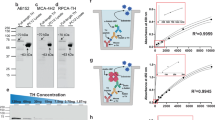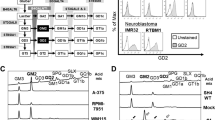Summary
S-100 protein (S-100p) is a small, acidic, calcium-binding protein that is present (predominantly) in the cytoplasm of many types of cells including those of neuroectodermal origin, such as glial cells, schwann cells and melanocytes. In human melanoma cells S-100p is abundant relative to the small quantities expressed by normal melanocytes. We investigated the possibility that this protein may be a growth factor. Purified S-100p from bovine brain or human melanoma cells was added exogenously to human melanoma cells and peripheral blood lymphocytes (PBL) and their growth in the presence of different concentrations of S-100p was determined using a [3H]dT-uptake proliferation assay. The growth of melanoma cells was stimulated by S-100p at concentrations of 1.95–31.25 μg/ml. Slight inhibition of cell proliferation occurred at high concentrations (125 μg/ml). Maximum stimulation of PBL was at 31.25 μg/ml. PBL were not inhibited even at high concentrations of S-100p (125 μg/ml). PBL stimulation by S-100p did not require the presence of monocytes/macrophages. Though stimulation by S-100p is not restricted to a specific cell type, when released by melanoma cells it may function as an “autocrine” tumor growth factor. Other cells, such as PBL, coming in contact with S-100p are also stimulated to proliferate.
Similar content being viewed by others
References
Baudier J, Glasser N, Haglid K, Gerard D (1984) Purification, characterization and ion binding properties of human brain S100b protein. Biochim Biophys Acta 790:164
Chafouleas JG, Means AR (1984) An important role for calmodulin in cell proliferation. Prog Cancer Res Ther 29:343
Cochran AJ, Wen DR (1985) S100 protein as a marker for melanocytic and other tumours. Pathology 17:340
Cochran AJ, Holland GN, Wen DR, Herschman HR, Lee WR, Foos RY, Straatsma BR (1983) Detection of cytoplasmic S100 protein in primary and metastic intraocular melanomas. Invest Ophthalmol Vis Sci 24:1153
Cochran AJ, Wen DR, Herschman HR, Gaynor RB (1983) Detection of S-100 protein as an aid to the identification of melanocytic tumors. Int J Cancer 30:295
Cochran AJ, Pihl E, Wen DR, Hoon DSB, Korn EL (1987) Variations in reactivity of individual regional lymph nodes draining malignant melanoma: histologic and immunohistologic studies. J Natl Cancer Inst 78:399
Donato R (1986) S100 proteins. Cell Calcium 7:123
Donato R, Cittadini A, Bossi D (1984) S100 protein fails to potentiate the effect of the Ca2+ ionophore A23187 on isolated nerve endings. Vizi ES, Magyar K (eds) Proc 4th Meet Eur Soc Neurochem. Elsevier Science, New York, NY, p 381
Fan K (1982) S100 protein synthesis in cultured glioma cells is Gl-phase of cell cycle-dependent. Brain Res 237:498
Gallo V, Levi G, Raiteri M, Coletti A (1980) A nervous system specific protein potentiates the biological effects of the calcium ionophore. Life Sci 27:761
Gaynor R, Herschman HR, Irie R, Jones P, Morton D, Cochran AJ (1981) S100 protein: a marker for human malignant melanomas? Lancet 1:869
Gaynor R, Irie R, Morton D, Herschman HR (1981) S100 protein is present in cultured human malignant melanomas. Nature 286:400
Hoon DB, McBride B, Irie RF, Jung T, Naungayan J, Cochran AJ (1986) Effect of gangliosides of human macrophage functions. J Leukocyte Biol 40:255
Hoon DBS, Korn EL, Cochran AJ (1987) Variations in functional immunocompetence of individual tumor-draining lymph nodes in man. Cancer Res 47:1740
Ishikawa H, Nogami H, Shirasawa N (1982) Novel clonal strains from adult rat anterior pituitary producing S100 protein. Nature 303:711
Isobe T, Ichimori K, Nakajima T, Okuyama T (1984) The a subunit of S100 protein is present in tumor cells of human malignant melanoma, but not in schwannoma. Brain Res 294:381
Kanamori M, Endo T, Shirakawa S, Sakurai M, Hidaka H (1982) S-100 antigen in human T lymphocytes. Biochem Biophys Res Commun 108:1447
Kincaid RL, Coulson CC (1985) Rapid purification of calmodulin and S-100 protein by affinity chromatography with melittin immobilized to sepharose. Biochem Biophys Res Commun 133:256
MacNeil S, Walker SW, Senior HJ, Bleehen SS, Tomlinson S (1982) Effects of extracellular calmodulin and calmodulin antagonists on B16 melanoma cell growth. J Invest Dermatol 83:15
Marshak DR, Watterson DM, Van Eldik LJ (1978) Calcium-dependent interaction of S100b, troponin C and calmodulin with an immobilized phenothiazine. Proc Natl Acad Sci USA 78:6793
Moore BW (1965) A soluble protein characteristic of the nervous system. Biochem Biophys Res Commun 19:739
Nakajima T, Watanabe S, Sato Y, Kameya T, Shimosato Y (1981) Immunohistochemical demonstration of S-100 protein in human malignant melanoma and pigmented nevi. Gann 72:335
Perumal AS, Rapport MM (1978) In vitro phosphorylation of S-100 protein by brain nuclear protein kinases. Life Sci 22:803
Rosenberg SA, Speiss P, Lafreniere R (1986) A new approach to adoptive immunotherapy of cancer with tumor-infiltrating lymphocytes. Science 233:1318
Takemoto D, Jilka C (1983) Increased content of calmodulin in human leukemia cells. Leukemia Res 7:97
Van Eldik LJ, Hertzberg EL, Berdan RC, Cilula NB (1985) Interaction of calmodulin and other calcium-modulated proteins with mammalian and arthropod junctional membrane proteins. Biochem Biophys Res Commun 126:825
Veigl ML, Vanaman TC, Sedwick WD (1984) Calcium and calmodulin in cell growth and transformation. Biochim Biophys Acta 738:21
Watanabe K, West W (1982) Calmodulin activated cyclic nucleotide phosphodiesterase, microtubules and vinca alkaloids. Fed Proc 41:2292
Author information
Authors and Affiliations
Rights and permissions
About this article
Cite this article
Klein, J.R., Hoon, D.S.B., Nangauyan, J. et al. S-100 protein stimulates cellular proliferation. Cancer Immunol Immunother 29, 133–138 (1989). https://doi.org/10.1007/BF00199288
Received:
Accepted:
Issue Date:
DOI: https://doi.org/10.1007/BF00199288




